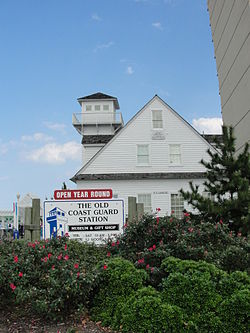Old Coast Guard Station Museum
|
U.S. Coast Guard Station
|
|
 |
|
| Location | Atlantic Ave. and 24th St., Virginia Beach, Virginia |
|---|---|
| Coordinates | 36°51′11″N 75°58′35″W / 36.85306°N 75.97639°WCoordinates: 36°51′11″N 75°58′35″W / 36.85306°N 75.97639°W |
| Area | less than one acre |
| Built | 1903 |
| NRHP Reference # | 79003304 |
| VLR # | 134-0047 |
| Significant dates | |
| Added to NRHP | July 11, 1979 |
| Designated VLR | March 20, 1979 |
The Old Coast Guard Station Museum honors and preserves the history of Virginia's maritime heritage, coastal communities, the United States Lifesaving Service, and the United States Coast Guard along the Atlantic coast.
In 1790, the United States Congress empowered the Secretary of the Treasury Alexander Hamilton to construct ten cutters to acquire custom duties from foreign ships visiting the ports of the young nation. The ten cutters provided 92% of the young nation's income with collections of custom duties. In six years the young nation's debt was paid off to foreign countries. The role of the Revenue Cutter Service would expand to protecting the young nation in times of national security. The Revenue Cutter Service would be placed under the control of the United States Navy. This practice continues today with authorization from the President of the United States. The organization and rank formation of the United States Coast Guard coincides with the United States Navy for such emergencies. The officers and crew of the US Revenue Cutter Service would collect a percentage of the fines, penalties, and forfeitures collected from offenders.
In 1878 the United States Congress passed a law that would join the Revenue Cutter Service and the United States Life-Saving Service to provide assistance to persons that had been shipwrecked. The joining of the two concerns; in regards to Life-Saving was a success. In 1882 superintendent of the United States Life-Saving Service Sumner I. Kimball wrote in a report that the success of the United States Life-Saving Service was enhanced by the Revenue Cutter Service. Sumner I. Kimball stated that "little wonder the United States Life-Saving Service has succeeded; the souls of such men have entered it, and it has become an incarnation. In the later years, the efforts of the two Services would help create the United States Coast Guard. The United States Revenue Cutter Service success is shown over a five year period from 1881 to 1885. The numbers that are shown are a yearly average: Saved from drowning 87, assisting vessels in distress 208, value of cargo on vessels $4,498,078, maintenance cost $843,595.
...
Wikipedia


